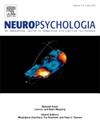多时间尺度上言语和非言语时间信息的神经加工中的半球偏侧性
IF 2
3区 心理学
Q3 BEHAVIORAL SCIENCES
引用次数: 0
摘要
许多研究已经研究了响应言语时间信息的多波段神经振荡活动的半球偏侧性,但它们的言语和语言特异性仍然难以捉摸。在本研究中,我们利用脑磁图研究了语言和非语言刺激的theta (4 - 8hz)和高γ波段(超过80hz)活动的侧性模式,它们分别与颞包络和精细结构相锁定。以基频为80 Hz的单调语音(MS)及其反向声(bMS)作为语音刺激。我们还利用具有与MS相同的时间包络但没有精细结构的噪声-vocoded语音(NVS)及其后向音(bNVS)来研究时间精细结构对多波段振荡活动的影响。采用5 Hz调幅80 Hz的咔嗒声序列(AMC)和噪声(AMN)作为非言语刺激。我们证实了精细结构的言语和非言语刺激(MS, bMS和AMC)在右半球引起的5 Hz和80 Hz的活动比左半球强。在语言专一性方面,我们发现右半球的5赫兹功率在向后语音条件下比向前语音条件下下降(MS >;bMS和NVS >;吴运前)。这些结果表明右半球在颞精细结构的听觉加工中起着重要作用,与语音和非语音一样,右半球具有高伽马带活动。此外,与右半球颞包络相锁的θ波段活动有助于语音信号的识别。本文章由计算机程序翻译,如有差异,请以英文原文为准。
Hemispheric laterality in neural processing of speech and non-speech temporal information on multiple timescales
Numerous studies have investigated hemispheric laterality of multi-band neural oscillatory activities in response to speech temporal information, but their speech- and language-specificity remain elusive. In the present study, using magnetoencephalography, we examined laterality patterns of theta (4–8 Hz) and high gamma-band (more than 80 Hz) activities phase-locked to temporal envelope and fine structure, respectively, of speech and non-speech stimuli. Monotone speech (MS) with a fundamental frequency of 80 Hz and its backward sound (bMS) were used as speech stimuli. We also used noise-vocoded speech (NVS), which has the same temporal envelope as MS, but no fine structure, and its backward sound (bNVS) to investigate the effects of temporal fine structure on multi-band oscillatory activities. A 5 Hz amplitude-modulated 80 Hz click-train (AMC) and noise (AMN) were used as non-speech stimuli. We confirmed that speech and non-speech stimuli with fine structure (MS, bMS, and AMC) caused stronger 5 Hz and 80 Hz activities in the right than in the left hemisphere. Regarding the language specificity, we found that the 5 Hz power in the right hemisphere decreased in backward compared to forward speech conditions (MS > bMS and NVS > bNVS). These results suggest that the right hemisphere plays an important role in auditory processing of temporal fine structure through high gamma-band activity in common with speech and non-speech sounds. In addition, theta-band activity phase-locked to the temporal envelope in the right hemisphere contributes to recognition of speech signals.
求助全文
通过发布文献求助,成功后即可免费获取论文全文。
去求助
来源期刊

Neuropsychologia
医学-行为科学
CiteScore
5.10
自引率
3.80%
发文量
228
审稿时长
4 months
期刊介绍:
Neuropsychologia is an international interdisciplinary journal devoted to experimental and theoretical contributions that advance understanding of human cognition and behavior from a neuroscience perspective. The journal will consider for publication studies that link brain function with cognitive processes, including attention and awareness, action and motor control, executive functions and cognitive control, memory, language, and emotion and social cognition.
 求助内容:
求助内容: 应助结果提醒方式:
应助结果提醒方式:


